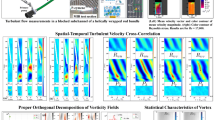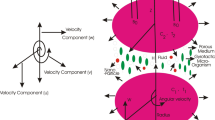Abstract
An electrochemical technique has been employed for determining the hydrodynamic characteristics and reaction rate constants for the bipolar trickle reactor as a whole. Theoretical descriptions of modified flow models have been derived and experimental data have been fitted to these descriptions both in the time and Laplace domains. A model with both fast and slow-moving phases gives excellent agreement with experimental curves, although a simple dispersion model is seen to be a reasonable approximation. Differences due to changes in the boundary conditions are shown to be small. The rate constant for a first order reaction has been found to be linearly dependent on the film Reynolds number, suggesting that mass transfer to the active areas within the reactor dominates the measured performance for reactions such as copper deposition.
Similar content being viewed by others
Abbreviations
- A 1 :
-
extent of the fast-moving zone (cm)
- A 2 :
-
extent of the slow-moving zone (cm)
- C :
-
amplitude of the response curve (arbitrary units)
- C 0 :
-
tracer concentration in the fore section of the reactor (mol cm−3)
- C 1 :
-
tracer concentration in the region where the concentration perturbation takes place (mol cm−3)
- C 2 :
-
tracer concentration within the reactor, or in fast-moving phase (mol cm−3)
- C 3 :
-
tracer concentration in the after section of the reactor (mol cm−3)
- C 4 :
-
tracer concentration in the slow moving phase (mol cm−3)
- C 0 :
-
area under the response curve for the inactive bed (mol cm−3 s) or initial concentration of the tracer injected over the cross-section of the reactor (mol cm−3)
- D :
-
dispersion coefficient (cm2 s−1)
- F :
-
Faraday constant
- h :
-
film thickness (cm)
- J=0, 1, 2 ...:
-
number of active (or inactive) zones in zoned reactor
- (j+1)b :
-
length of zoned reactor (cm)
- (j+1)a :
-
length of active part of zoned reactor (cm)
- (j+1) (b−a) :
-
length of inactive part of zoned reactor (cm)
- J 0 :
-
Bessel function of zero order
- k/h :
-
first order reaction rate constant (s−1)
- k′ :
-
mass transfer coefficient between fast and slow moving phases (cm s−1)
- k m :
-
mass-transfer coefficient (cm s−1)
- L :
-
length of the reactor (cm)
- n :
-
number of electrons transferred in an electrochemical reaction
- n r :
-
number of the rings in a single layer of packed column
- (Pe):
-
Peclet number (uL/D)
- Q :
-
amount of tracer injected (mol)
- r :
-
reaction rate per unit area (mol cm−2 s−1)
- r i,r o :
-
inner and outer radii of Raschig ring, respectively
- (Re)f :
-
film Reynolds number\(\left[ {\frac{v}{{2\pi n_r (r_o + r_i )v}}} \right]\)
- s :
-
Laplace variable (s−1)
- S :
-
contact area per unit length between fast and slow-moving phase
- t :
-
time (s)
- ¯t :
-
mean time (s)
- u :
-
mean liquid velocity (cm s−1)
- ν :
-
liquid volumetric flow rate (cm3 s−1)
- x :
-
spatial reactor co-ordinate (cm)
- α :
-
the parameter\(\left[ {\left( {s + \frac{{u^2 }}{{4D}}} \right)^{1/2} \frac{1}{{D^{1/2} }}} \right]\)
- β :
-
the parameter\(\left[ {\left( {s + \frac{k}{h} + \frac{{u^2 }}{{4D}}} \right)^{1/2} } \right]\)
- γ :
-
the parameteru/(2D)
- Δ :
-
region where the concentration perturbation occurs (cm)
- η :
-
electrode overpotential (V)
- θ n :
-
roots of Equation 23
- ν :
-
kinematic viscosity (cm2 s−1)
- ϱ :
-
specific solution resistivity (Ω cm)
- σ 2 :
-
variance (s2)
- τ :
-
residence time (s)
- φ s :
-
potential in the solution phase (V)
- ω :
-
fraction of the reactive area of a bipolar reactor (dimensionless)
References
M. Fleischmann and Z, Ibrisagić',J. Appl. Electrochem. 10 (1980) 151.
V. G. Levich, V. S. Markin and A. Chismadzhev,Chem. Eng. Sci. 22 (1967) 1357.
R. W. Michell and I. A. Furzer,Trans. Tustn. Chem. Engrs. 50 (1972) 334.
B. A. Buffham, L. G. Gibilaro and M. N. Rathor,AICHE J.,16 (1970) 218.
V. G. Rao and Y. B. G. Varma,ibid 22 (1976) 612.
O. Levenspiel and W. K. Smith,Chem. Eng. Sci. 6 (1957) 227.
O. Levenspiel, ‘Chemical Reactor Engineering’ 2nd edn, Wiley, London (1972).
P. N. Danckwerts,Chem. Eng. Sci. 2 (1953) 1.
J. Villermaux and W. P. M. van Swaaij,ibid 24 (1969) 1097.
W. P. M. van Swaaij, J. C. Charpentier and J. Villermaux,ibid 24 (1969) 1083.
A. Bennet and F. Goodridge,Trans. Instn. Chem. Engrs. 48 (1970) 232.
R. W. Mitchell and I. A. Furzer,Chem. Eng. J. 4 (1972) 53.
I. Justinijanović, PhD Thesis, University of Southampton (1975).
Z. Ibrisagić, PhD Thesis, University of Southampton (1977).
M. Fleischmann and Z. Ibrisagić,J. Appl. Electrochem. 10 (1980) 169.
J. F. Wehner and R. H. Wilhelm,Chem. Eng. Sci. 6 (1956) 89.
E. Th. van der Laan,ibid 7 (1958) 187.
D. J. Gunn,Chem. Eng. CE-153 (1968).
M. Fleischmann, J. W. Oldfield and C. L. K. Tennakoon,Symposium on Electrochemical Engineering, University of Newcastle-upon-Tyne,1 (1971) 53.
C. L. K. Tennakoon, PhD Thesis, University of Southampton (1972).
Author information
Authors and Affiliations
Rights and permissions
About this article
Cite this article
Fleischmann, M., Ibrisagić, Z. Examination of flow models for bipolar trickle reactors. J Appl Electrochem 10, 157–168 (1980). https://doi.org/10.1007/BF00726080
Received:
Revised:
Issue Date:
DOI: https://doi.org/10.1007/BF00726080




